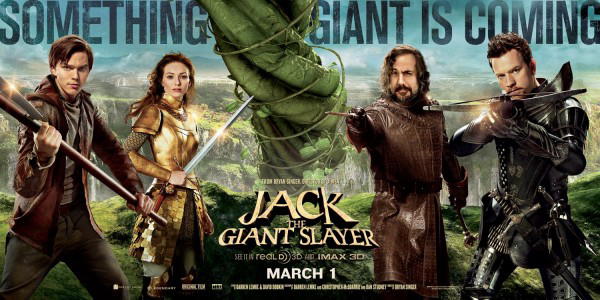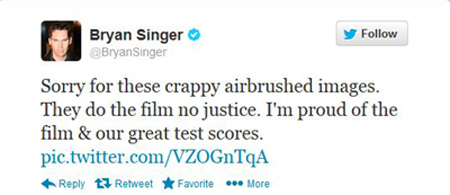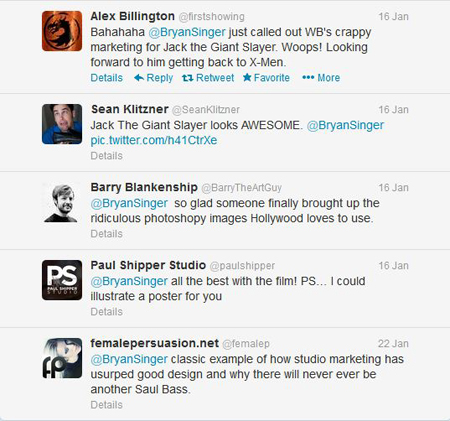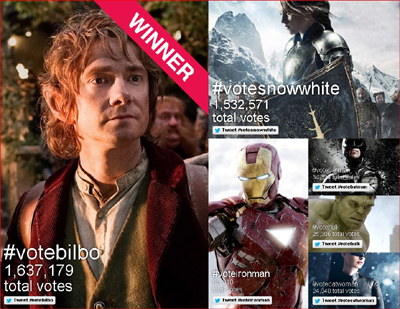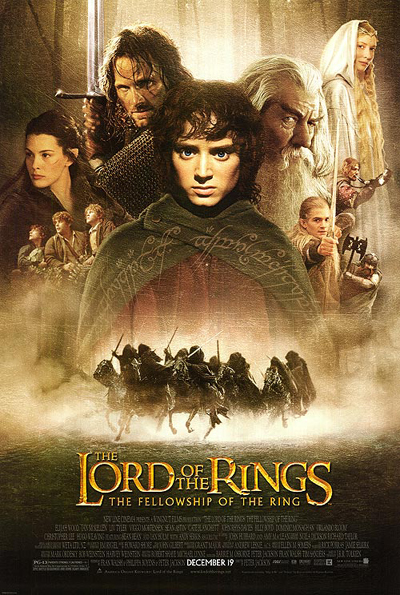Jack and the Bean-counters
Tuesday | May 7, 2013 open printable version
open printable version
Kristin here:
I don’t know about you, but back on January 16 about the last thing on my mind was the release, still six weeks away, of Jack the Giant Slayer. It wasn’t a film I was planning to see. Not many people were, as it predictably turned out. I was more concerned with a recent release, The Hobbit: An Unexpected Journey, and whether the decision to turn a two-part film into a trilogy had adversely affected the narrative. I posted my some-good-news-some-bad-news entry that day.
Not as giant as they might think
It turned out on that same day there were some fans of fantasy films and/or Bryan Singer, the director of Jack, who were exercised about the recently released poster for the film (reproduced above). I discovered this from a Hollywood Reporter story published in the wake of Jack’s disappointing opening weekend, when it grossed $27.2 million domestically. The story led off with an anecdote about the poster kerfuffle:
When Bryan Singer sat down at his computer in mid-January and read Internet comments criticizing a new Warner Bros. poster for his big-budget epic Jack the Giant Slayer, he fumed. He didn’t care for the cartoonish image of the film’s stars brandishing swords and standing around a swirling beanstalk. So Singer complained on Twitter. “Sorry for these crappy airbrushed images,” he wrote Jan. 16, irking Warners’ powerful marketing head Sue Kroll. “They do the film no justice. I’m proud of the film & our great test scores.” An insider confesses, “Bryan felt like he had to apologize to his fans.”
This gesture annoyed studio executives, who demanded that Singer take it down. He hasn’t. The apology won him some points with the fans, as some sample tweets in response show:
Do any current Warner Bros. executives know who Saul Bass was? More to the point, do the studios have any idea how much fan devotion is gained by directors like Singer, Peter Jackson, and Guillermo del Toro, who try to communicate directly with the fans as often as they are allowed to, and even sometimes when they aren’t? If the studios did have any idea, they would encourage directors to hold question-and-answer sessions on fan sites and communicate via social media far much more than they do now. I suspect studios give up tens of millions of dollars in free publicity by treating fans as potential spies, spoiler-mongers, and authors of vicious reviews based on trailers.
Ring? What Ring?
This disappointment with Jack’s poster reminded me of an incident that happened late in the filming of The Lord of the Rings. I describe it in The Frodo Franchise:
On 16 Dcember 2000, New Line’s president of domestic theatrical marketing, Joe Nimziki, met with the director concerning the Rings publicity campaign. One of his purposes in visiting Wellington was to meet the cast, who would be involved in the upcoming press junkets, parties, and premieres. The occasion soured when the filmmakers and actors saw the proposed poster design. Based on its audience research, New Line had concluded that Rings would appeal primarily to teenage boys, and the design was busy and garish. The actors backed Jackson up, threatening not to participate in the marketing campaign if it proceeded along those lines. Jackson had a mock-up poster made, featuring muted tones and a simply design centered on an image of the One Ring. The design was not used, but it gave New Line a sense of what the filmmakers considered appropriate. (p. 81)
When I made my first research trip to Wellington in 2003, I had no idea that this incident had occurred. Someone high in the production mentioned it to me out of the blue during an interview, which led me to think that this person considered it important and wanted me to mention it. After nearly three years, it obviously had remained a sore point. (I did describe the incident, but in general I portrayed the few mistakes I mentioned in my book as part of a learning curve that the studio benefited from.) Unfortunately I have never seen the offending poster design. I have seen one of what were apparently two mock-up copies of Jackson’s version made, on the basis of which I wrote the brief description above. The design was too muted in color and minimalist in layout to be useable, but it evidently served its purpose.
Obviously there’s a big difference between the handling of these two offending poster designs. New Line, which produced The Lord of the Rings, took the trouble to show the cast and crew the planned poster and acceded to their wishes about replacing it. As a result, the cast participated in the many press junkets and other publicity events. I’m not sure which poster design for The Fellowship of the Ring convinced the cast, but the one at the bottom of this entry was the main one used. Definitely better than the one for Jack at the top.
Warner Bros. presumably did not bother to show Singer the poster, or test it on fans, or do anything to make sure that it would boost rather than dampen potential moviegoers’ enthusiasm. It is as conventional a poster as one could imagine for such an expensive film.
The irony in all this is that New Line also produced Jack the Giant Slayer. Due to various post-Lord of the Rings failures, primarily The Golden Compass, New Line is now a production unit within Warner Bros. It doesn’t handle its own distribution or marketing, having been downsized by about 80 percent. Warners takes care of everything except the production itself.
Doesn’t amount to a hill of beans
Jack’s opening weekend’s gross was followed by a nearly 64 percent drop during its second weekend. It just went into second run last week, so its theatrical life is rapidly tapering off. In the same Hollywood Reporter story that alerted us to the poster tweets, author Pamela McClintock called Jack “the latest in a string of dismal 2013 domestic releases.” She added,
Revenue and attendance are both down a steep 15 percent from the same period in 2012, wiping away gains made last year. Jack may have cost far more than any of the other misses, but in assessing the carnage, there’s a collective sense that Hollywood is misjudging the moviegoing audience and piling too many of the same types of movies on top of one another.
I think that collective sense is shared by almost every ordinary viewer. Jack the Giant Slayer. Really? For that matter, Hansel and Gretel: Witch Hunters? Upon merely hearing these titles, I didn’t expect them to be hits. In the wake of The Lord of the Rings and the Harry Potter series, Hollywood has been pushing fantasy harder and harder, but there is a limit. I think that has been reached with the mini-trend toward adapting fairy tales with adults in the lead child roles. Making Jack a “giant slayer” (grammar-police note: this should be “giant-slayer”) doesn’t hide the fact that this is really “Jack and the Beanstalk” re-titled by committee.
Recently Variety reported that the success of Alice in Wonderland early in the year (it was released in March, 2010) has led studios to release films of the summer-tentpole type well before the traditional Memorial Day weekend opening of the summer season: “Warner Bros. started this year’s March madness with the pricey Jack the Giant Slayer, which never sprouted.” Disney’s Oz the Great and Powerful opened one week later.
Now there’s a film I wanted to see, and many others did, too. It’s currently still in first run and pushing toward the $500 million mark worldwide. With a reported $215 million budget plus publicity costs, that’s not a big hit (it’ll probably become profitable in Blu-ray, streaming, etc.), but it’s doing a lot better than Jack. Jack’s budget is reported at slightly under $200 million, with marketing costs of over $100 million. As of now it has grossed a little under $200 million worldwide. A week after Oz, The Croods appeared, aimed to some extent at the same audience as the two films that preceded it. In short, Hollywood is not only making a lot of children’s fantasies, adapted to a broader audiences including adults, but it is releasing them opposite each other.
Fans? what fans?
This is not to say that all such films fail. I found Oz a clever film, better than most critics have given it credit for. It presents an imaginative riff on the 1939 The Wizard of Oz as if it had been made using classical storytelling techniques but with digital technology.
But back to that claim that “Hollywood is misjudging the moviegoing audience.” It’s hard to imagine a group of executives sitting around a big table and seriously thinking that an expensive digital extravaganza based on “Jack and the Beanstalk” would bring people flocking to theaters, yet they did. Why? Possibly because they are out of touch with the fandoms they depend on.
Back when I was researching the Lord of the Rings online fandom and its relationship to New Line’s publicity department, it seemed that Hollywood was beginning to understand fans. It was a hard learning process, but New Line’s executives reluctantly gave some big websites occasional access to sets and once in a while sent them news exclusives. Such openness, grudging though it was, generated free publicity and goodwill. The studio also allowed Peter Jackson to interact with fans, though in strictly controlled circumstances.
Warner Bros. is a different animal altogether, and it has squandered much of what goodwill New Line gained in those days. The Jack the Giant Slayer poster controversy provides perhaps one clue as to how indifferent studios now are to their public and how much their insularity can damage their bottom lines.
The Hobbit: An Unexpected Journey, made by New Line under the tight control of Warner Bros., has of course done very well financially. It grossed over a billion dollars worldwide–though just barely, at $1,017,003,568. If we could adjust worldwide figures for inflation (impossible due to different inflation rates in different countries), each installment of The Lord of the Rings would undoubtedly turn out to have earned more. This despite all the surcharges for the many 3D screenings of The Hobbit.
Why didn’t it do quite as well as the previous entries in the franchise? Perhaps some people who had liked Rings were put off by their perception of The Hobbit as more of a children’s film. Perhaps it was partly the reviews, which were considerably less enthusiastic than for any of the three parts of Rings.
I wonder, though, if Warner Bros.’s lack of interest in the fans might have had something to do with it. Consider what New Line had done for fans in the marketing of Rings as compared to what Warner Bros. has done with The Hobbit. New Line started a pioneering website, managed by Gordon Paddison, that drew millions of fans long before The Fellowship of the Ring appeared. Gordon Paddison, now running his own publicity firm, has created a Hobbit website as well, but it’s primarily a large ad for the Blu-ray and DVD, with none of the free wallpapers and other items that were so popular on the Rings site. Even a live online event from March 24, during which Peter Jackson answered fan questions, was re-posted there without the brief preview footage from The Desolation of Smaug–an unkind cut that annoyed fans greatly. This was especially unfair because to log in to the live event, one needed a code enclosed in the Blu-ray/DVD package, and the Blu-ray release hadn’t occurred in many part of the world by March 24. Not good public relations.
The main online publicity venue for The Hobbit has been Jackson’s own Facebook page, where ten production vlog entries were posted at wide intervals. These later became the main supplements for the theatrical DVD release. Given the breezy, open tone of these vlog entries, it seems possible that they can be credited more to Jackson’s initiative than Warner Bros.’s.
New Line also licensed a company to create a fan club for The Lord of the Rings, complete with an excellent bimonthly magazine. A considerable amount of effort was put into the eighteen issues that appeared, including interviews not only with the filmmakers but with the makers of licensed tie-in products. Fans were encouraged to send in questions for the interviewees, and some of these got included. The names of the charter members of the club were run in a crawl after the credits of the extended-edition versions of the DVDs, a process that, even at a rather fast clip, ran for about twenty minutes. This won huge loyalty from fans, even those who joined later and didn’t get into that crawl-title.
For The Hobbit, there was no fan club and no magazine. I can imagine that the Rings fan club generated a relatively small income for New Line compared to the many other licensed items, but it created much enthusiasm among fans. The film’s official Facebook page is a feeble substitute.
For decades people have been saying that Hollywood executives are out of touch with their audiences, make too many movies, spend too much on their movies–especially in age of special-effects-based blockbusters. It’s an old complaint but one that may be a genuine and growing problem as executives with no personal film production experience control the output of studios owned by huge corporations.
The Hollywood Reporter story that began with the anecdote about Singer’s apologetic tweet ends with some insight:
Privately, studio executives concede that Jack was a feathered fish, neither a straight fanboy tentpole that Singer (X-Men, Superman Returns) is famous for nor a pure family play. “Sometimes you simply have a movie that is rejected,” laments one Warner executive, a common refrain these days in Hollywood. “You can spend as much as you want, market it a zillion different ways, and it still doesn’t work.”
Someone might point out that Jack and Rings are not comparable projects. Rings was adapted from a beloved classic and already had a significant fan base. Jack was not based on a novel and had no such fan base. But I believe that the big studios view fantasy as a genre with a broad, somewhat unified fan base consisting of people who will go to see just about any fantasy film. The failures of not only Jack and Hansel and Gretel but also of others like Mirror, Mirror show that that’s not the case.
The answer is out there
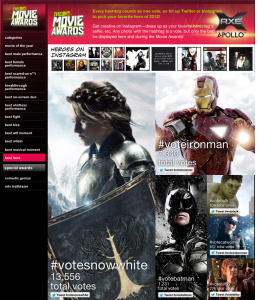 One solution to the studios’ isolation could be to get on the Internet, keep tabs of the huge amount of fan opinion already there and appearing every day, and get a sense of what the real audience wants.
One solution to the studios’ isolation could be to get on the Internet, keep tabs of the huge amount of fan opinion already there and appearing every day, and get a sense of what the real audience wants.
For a start, there is no “fantasy” fandom. There are fandoms around specific stories or series or movies or games. They create websites and Facebook pages and videos. Many fans are quite smart and understand the conventions of the fantasy genre. They know how the industry markets things to them. (Witness all the accusations that fly when a studio repackages a film yet again as a DVD/Blu-ray with only minimal changes in the supplements.) They know exactly what they want marketed to them and what they don’t want. Richard Taylor, the head of Weta Workshop, which designed many of the collectibles as well as the Rings and Hobbit films, is a hero to fans. Affluent Rings fans who get married can commission Daniel Reeves, the calligrapher for the franchise, to design their wedding invitations. Denny’s Hobbit meals, on the other hand, are viewed variously as merely amusing to downright offensive.
There are also rivalries among fandoms. Ask a Ringer and a Harry Potter fan who is the greater wizard, Gandalf or Dumbledore, and watch the feathers fly.
There was a vivid example of this just last month. The MTV Awards nominations for 2012 were posted for fans to vote on. In the Best Hero category there were Snow White (the Snow White and the Huntsman version), Batman, Catwoman, Iron Man, Hulk. and Bilbo Baggins. Shortly into the voting, Snow White was at first place with 13,556, with Bilbo dead last with 226 (left).
Snow White beating Iron Man and Batman? Ringers realized at once that this was not an overwhelming vote for Snow White but for Kristen Stewart, and it was happening because of the Twihards–the devotees of the Twilight series.
Rallying around, Ringers began trying to get people to Vote Bilbo. Fans created memes for tweeting and re-tweeting. TheOneRing.net, the biggest Tolkien website, got involved in helping coordinate individual efforts into a unified campaign to spread the word. Spiegel Ei posted a amusing video on Vimeo, “put a ring on it #VoteBilbo,” in which Bella Swan (Stewart’s character in the series) meets several Rings characters, reads Tolkien’s novel, researches it on the Internet, and abandons her world for Middle-earth. The short film was so clever that MTV’s website even featured a news story , linking to it–a strange case of bias that may have helped sway the voters. (The # symbol in the title comes from the fact that fans could vote only by tweeting for one of the six nominees.)
Even so, during the final exciting week, the MTV vote seesawed back and forth between Snow White and Bilbo, but the Ringers’ campaign won out, with Bilbo attaining a margin of just over 100 thousand:
Measured by the box-office records of all the films, Snow White would seem to be least popular. Yet it wasn’t the ticket-buying audience as a whole voting. It was the hardcore fans–and mostly fans from a different fandom at that.
Cliff “Quickbeam” Broadway has posted an excellent rundown of the campaign on TheOneRing.net, “When Fandom Comes Together: How #VoteBilbo Rallied the Ringers.” It conveys how a large number of devotees worked very hard for free to create an almost professional-level campaign for a character and film they loved. All this within the space of a few weeks.
I’m not saying that a studio marketer could go onto the Internet and find hard facts on fans’ likes and dislikes. It’s something one gets a feel for by looking at the message boards on TheOneRing.net or checking out The Leaky Cauldron (the biggest Harry Potter fansite) or liking a bunch of directors’ and films’ Facebook pages. By the way, it’s odd that Peter Jackson has a FB page that, with its nearly 800 thousand Likes, has become the main online publicity site for The Hobbit, while Bryan Singer doesn’t even have a FB page. Does that suggest any systematic approach in WB’s publicity campaigns? True, Jack has a FB page, but these days every film does.
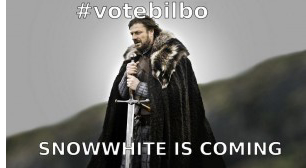 What sorts of things can you learn by looking at such sites and pages? It’s interesting, for example, that Cliff’s fandom story includes one of many images that were devised by fans for the twitter campaign for Bilbo, one not from Rings or The Hobbit, but from Game of Thrones (right). Ringers would instinctively know that Lord of the Rings fans would be far more likely to read George R.. R. Martin’s book series or watch the TV adaptation than would Twihards. Not only would they recognize the image shown (the character played by Sean Bean, who was Boromir in The Fellowship of the Ring), but they would know that “Snowwhite is coming” is a riff on a portentous line from Game of Thrones, “Winter is coming.”
What sorts of things can you learn by looking at such sites and pages? It’s interesting, for example, that Cliff’s fandom story includes one of many images that were devised by fans for the twitter campaign for Bilbo, one not from Rings or The Hobbit, but from Game of Thrones (right). Ringers would instinctively know that Lord of the Rings fans would be far more likely to read George R.. R. Martin’s book series or watch the TV adaptation than would Twihards. Not only would they recognize the image shown (the character played by Sean Bean, who was Boromir in The Fellowship of the Ring), but they would know that “Snowwhite is coming” is a riff on a portentous line from Game of Thrones, “Winter is coming.”
It is also interesting that TheOneRing.net catered to the slightly older-skewing demographic that is far more important in Rings fandom than in Twilight fandom. As Cliff says: “We have an audience that included older-generation folks who had never used Twitter, so we gave quick and easy instructions to help guide our friends toward their goal.” New Line’s audience research, which originally convinced them that teenaged boys were their primary audience, didn’t reveal that other big audience–which most Ringers would know about.
These little details may not be important in themselves, but picking up many of them from fan discussion adds up to an overall view of characteristics and attitudes. Fans are also quite clear on their likes and dislikes as far as directors and stars go. Just the other day on a thread on TheOneRing.net, Lusitano gave his opinion concerning future possible adaptations of material from Tolkien’s The Silmarillion and Unfinished Tales: “If in the future they end up being adapted, it is only sensible to give them to someone else [other than Peter Jackson]. Tim Burton, perhaps? ” Such an adaptation would, I think, be unwise, but a producer who went down that road ought to be interested in that opinion.
Clearly from the way most studios treat most fan sites, they aren’t particularly grateful for any of this. They also don’t seem to recognize that the most devoted fans working for such sites or posting on their own FB pages, YouTube, and Vimeo, have an extraordinary expertise concerning one fandom and often several.
Possibly the studios do closely monitor fansites. Certainly some people in the Rings filmmaking team read TheOneRing.net. When Guillermo del Toro was slated to direct The Hobbit, he even joined the Message Boards and participated in discussions fairly frequently. Naturally the fans adored him for it. If he had stayed on as director, would WB have allowed him to keep up that practice? Probably not unless he cleared every contribution with the studio publicity department.
I’m not saying that cruising online fan outlets would guarantee that the studios would get such a feel for their public that all the films they greenlight would be successes. There are always inexplicable flops. Why did audiences who flocked to Tim Burton and Johnny Depp’s Alice in Wonderland reject the same team when Dark Shadows appeared? Was it just the difference between the sources: a universally known classic book vs. an old TV show with a devoted but small cult following?
Still, when I hear about such incidents as the ones I’ve described here, I can’t help but feel that the fans are a far more valuable source about potential audiences than the studios realize. Why do studios not identify certain particularly knowledgeable and devoted fans as experts and hire them as consultants? Or at least quietly study what they say and do and benefit from it? Maybe then they would know what many of us already know: that the impending failure of some films, like Jack and Hansel and Gretel, is bone obvious from the start.
All this is not to say that Jack the Giant Slayer is a bad film and not worth seeing. It has gotten some surprisingly good, if not rave reviews, though its score on Rotten Tomatoes is only 52% (and 61% among fans). It’s just that WB should have known what they were getting into.












